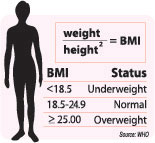The healthiest approach to gaining weight might be the same as that for losing it – eat healthy and exercise. Pop culture has made thinness synonymous with beauty, but many of those who are chronically and dramatically underweight would love to put on a few of those kilos, the rest of us are so eager to shed. This week Mediscene speaks with Dr. Noel Somasundaram, Consultant Endocrinologist on the causes that can trigger weight loss, what it means for your body and why you still need to be careful about packing on those calories.
Watching the scales:
For some of us, weight is simply a hereditary matter – lean body types often run in families, says Dr. Somasundaram. Children and young people, especially, are often very thin thanks to the very active lives they lead.
Though many patients are self-conscious teenagers who would like to appear a little more shapely, the people who most commonly struggle with weight loss belong to older generations. As we age, we lose muscle weight, in part due to ever decreasing levels of physical activity. One’s metabolic rate slows down, and that is accompanied by changes in how one smells and tastes food. As our senses become less sharp, the appetite suffers. However, for many elderly people the problem is even more obvious. Poor dental health and a loss of teeth might make chewing difficult, explains Dr. Somasundaram.
 |
While those born lean are often healthy enough, those who have lost muscle mass gradually tend to be weaker and more vulnerable to infections. Strenuous physical activity and coordination of movement will pose a challenge and the body takes a longer time to recover from illness or wounds. Both these types of weight loss must however, be clearly differentiated from abrupt weight loss. The latter could be caused by disease or infection and warrants a visit to the doctor.
Malabsorption of nutrients could be one cause of weight loss and can be traced back to the failure of the Gastro Intestinal tract, usually the small intestine, to extract all it can from your meal. There are a multiplicity of possible causes for malabsorption – but among the best known is insufficient production of digestive enzymes by the pancreas or small intestine.
However, your weight loss might also be a symptom of a disease. Tuberculosis infection, diabetes mellitus or cancer can also trigger dramatic weight loss. Successful treatment of the condition will return you to both good health and your normal weight. Alternately, a malfunctioning gland might release too much thyroid into your system. The condition is known as hyperthyroidism, and its other symptoms include increased perspiration, hand tremors, anxiety and thinning of the skin and hair. For a minority, unexplained weight loss can be traced back to an eating disorder such as anorexia nervosa or bulimia, which requires a psychologist to intervene.
No shortcuts:
It’s something of an irony that one of the best ways to put on weight might be to go on a crash diet. Keep that up for a while and then return to your usual high calorie intake and voila! Like any yo-yo dieter, you’ve discovered that the threat of starvation will only have your body hoarding its fat when things return to normal.
Unfortunately, it’s still not the right solution, says Dr. Somasundaram – weight put on in this fashion is almost always unhealthy fat. Unlike muscle, this fat build-up puts you at risk for all manner of diseases including abnormally high cholesterol levels, high blood pressure and cardiac disease.
Turning to food supplements can bring you the same results. Dubbing this ‘metabolic obesity’, he identifies it as particularly dangerous because it isn’t obvious. When it comes to a diet, people who don’t gain weight easily are likely to be less aware of how much saturated and trans-fat they eat. People in South Asia have a tendency to easily develop ‘trunkal obesity’ (the deposition of abnormally high quantities of fat in the abdomen and torso) even when they may not appear fat – a condition that again puts your health at risk.
The trick to putting on weight is to do it thoughtfully – managing it such that you put on muscle rather than fat. A holistic approach is required, and Dr. Somasundaram explains that bone strength is just one among many factors that should be considered. A thorough medical history will be needed to understand the genetic component. Once the possibility of a dangerous and potentially curable underlying disease is ruled out, then a dietician will be able to advise you on how to plan your diet and how to add more calories to your day’s intake.
What’s a healthy bodyweight?
Before you begin treatment, it’s important to know what exactly is meant by normal weight , emphasises Dr. Somasundaram. Calculating your Body Mass Index (BMI) will help you find the answer. Using your height and weight to measure your body fat, BMI applies to both men and women.
You can calculate your own by dividing your body weight by the square of your height (weight in Kg and height in Metres).
If the resulting figure is less than 17.5 than you can consider yourself officially underweight. A healthy BMI for a Sri Lankan body type should fall between 17.5 – 21 kg/m2 (which is less than the 25 accepted for westerners).
It’s clear then that for those who consider themselves too thin there are solutions (both good and bad) that you can adopt. But barring complications, you might find that in the end, maintaining your current weight is the healthiest choice you can make. |



